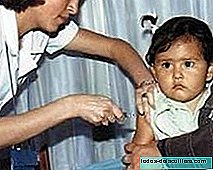
The controversy around the convenience of advancing or not the delivery, instead of waiting for it to occur spontaneously, is recurring.
On the one hand there are those who believe that it is induced too regularly, even at the whim of doctors or mothers, to ensure that the delivery takes place when it suits them. And they criticize the problems that this practice can cause to the child.
But there are also professionals, who they resort to inducing labor if they believe that the life of the mother or the baby is in danger. This option can even prevent the birth from ending in caesarean section.
Inducing labor is, according to the Spanish Society of Gynecology and Obstetrics (SEGO),
"The initiation of labor through medical or mechanical procedures before the spontaneous start thereof".
The study “Childbirth Care in Spain”, disseminated by the University of La Rioja, describes and analyzes the variability of perinatal care in our country, and concludes that:
"The result of a delivery depends much more on factors such as the geographical area or whether the hospital is public or private, than on the woman's own birth process."
This helps us to understand the difficulty of generalizing how childbirth is treated and to know if there is a tendency or not to induction in hospitals.
For that reason, we will try to be as objective as possible and meet the recommendations of the official health agencies for which we are governed in Spain: the World Health Organization and the Ministry of Health.
WHO, against instrumentalizing pregnancy
The World Health Organization (WHO) published a guide a few months ago that includes new recommendations for a positive birth experience. Its objective: "reduce unnecessary medical interventions" and offer mothers greater decision-making power over the birth process.
According to the WHO report, The majority of the 140 million births annually in the world occur without complications. However, in recent decades there have been:
"a substantial increase in the application of a variety of medical practices to start, accelerate, end, regulate or monitor the physiological process of childbirth".
Therefore, the new guideline presents 56 recommendations on childbirth care, mainly aimed at minimizing medical intervention in low-risk deliveries and in which there are no complications. Among them: that of Do not speed up labor unnecessarily through the routine application of oxytocin or other mechanisms.
The Normal Delivery Care Strategy in Spain

Most of the WHO recommendations are included in the Clinical Practice Guide on Normal Childbirth Care, published by the Ministry of Health in 2010.
In relation to the possibility of inducing labor, it establishes that fetal well-being is monitored by monitoring, but without performing an amniotomy (rupture of the amniotic bag) or routinely placing peripheral venous route.
The use of oxytocin will be limited to cases of need and the normal process of spontaneous membrane rupture to avoid possible complications will be respected.However, there are no official Health data to check if these standards are met or not in hospitals.
In the absence of more recent data, we rely on those contained in the Report on a Strategy for the Care of Normal Birth of the National Health System, revised in 2015 (page 19).
According to the report: oxytocin is used in 53.3% of natural births (compared to the standard provided by the good practice strategy (between 5-10%) and 19.9 of the deliveries were induced, compared to the maximum 10% recommended by WHO and 46.6 percent of them resorted to artificial rupture of the bag.
What does the Ministry of Health say about it?
The recommendations on the possibility of induction of the Ministry of Health, Social Policy and Equality are reflected in the National Strategy of Sexual and Reproductive Health, 2011 (pages 99 and 100).
Properly estimate gestational age by ultrasound in the first trimester, without basing it only on the date of the last menstrual period, which tends to overestimate it leading to a greater number of interventions due to prolonged pregnancy.
Inform pregnant women that in 5-10% of cases the pregnancy lasts beyond 42 weeks. Explain that after 40 weeks the risks to the fetus and the rate of caesarean sections begin to increase very slowly. The evidence does not categorically indicate the need to induce labor from a specific date, because it does not reduce some of the risks and may increase others.
Offer the pregnant woman from week 41 + 0 of gestation the possibility of waiting for the spontaneous onset of labor or of inducing labor throughout the week 41, with the best available method and adequate information.
When the woman refuses induction as of week 41, offer frequent surveillance through two weekly controls with techniques for assessing fetal well-being.
Induction of labor is an invasive and painful procedure. In order to make an informed decision and give consent, women require sufficient and reliable information, as well as time to make their decision. They must know the method of induction, place, details, support options and pain relief.
Identify by cardiotocogram those fetuses that are in a compromised situation, so that appropriate measures can be put in place to avoid irreversible damage. Begin the study of fetal well-being after week 40 in low-risk gestations.
End gestation before any sign of fetal commitment.
From week 41 of gestation
Precisely in the first point of the recommendations of the Ministry of Health "gestational age" is one of the points that generate more controversy about induction to childbirth.
The association Childbirth is our warning that Spanish hospitals induce protocol by birth around week 41 + 3, when the duration of a pregnancy ranges from 37 weeks to 42 (as noted by WHO).
But, Are there really so many prolonged pregnancies? The real problem in a large number of cases is the ignorance of the exact date of the last rule (FUR), which is why it is usually obtained from ultrasound of the first trimester of pregnancy, "method full of errors since it is set based on the size of the baby", according to the Birth is Ours.
Studies in favor of induction

But nevertheless, inducing labor is not always a negative option, according to the same association 'Childbirth is ours'. In addition, they explain the studies related to this practice.
Until 2003 there had been no complete scientific studies comparing the risks of an induction versus those of waiting for the delivery to be triggered naturally, even after the 42nd of pregnancy.
What was demonstrated is that:
"An induction in week 41 avoided one death for every 500 births, and as of this date each day increased the risk of mortality, even with daily monitoring."
Too it was accepted that routine induction near week 42 of gestation was associated with an increased need for caesarean section and with a greater loss of fetal well-being.
However, a review of the 2012 Cochrane researchers network, which includes 22 trials on the subject, concluded that:
"A policy of induction of labor compared to expectant behavior is associated with fewer perinatal deaths and fewer caesarean sections."And he adds that: "With a policy of inducing post-term labor, some morbidities of neonates such as meconium aspiration syndrome were also reduced."
And with these conclusions, the research indicates that:
"Women should be properly advised to make an informed choice between scheduled induction of post-term pregnancy or monitoring without induction (or delayed induction)."
According to these conclusions A new study from Northwestern University (Illinois, USA), published in the New England Journal of Medicine (NEJM), is shown. Notes that:
"Inducing labor at 39 weeks gestation can significantly reduce the chances that a first-time mother needs a C-section."The research involved more than 6,100 women in 41 different places in the United States. Women induced at 39 weeks experienced fewer caesarean births, lower rates of maternal and fetal complications, fewer newborns in need of breathing assistance and a lower incidence of preeclampsia.
And caesarean section, although also sometimes necessary for medical reasons, remains an intervention, with the risks involved. Therefore, It is better to seek natural childbirth whenever possible.
The researchers conclude that:
"The results of this new study refute the previous belief that suggested that inducing labor before 41 weeks increased the risk of cesarean delivery and the likelihood of serious complications."
Medical reasons to induce labor

The Spanish Society of Gynecology and Obstetrics (SEGO) recommends terminating pregnancy when “Maternal and fetal risks are less than the risk of continuing with it”.
SEGO protocols indicate labor induction in case of:
Post-term pregnancy The pregnancy lasts more than 42 weeks. From this moment the placenta usually stops working well enough to keep the baby healthy.
Premature rupture of membranes at term and preterm.
Cases of hypertension in pregnancy (preeclampsia, eclampsia and HELLP syndrome).
Maternal diabetes mellitus
Delayed fetal growth.
Twin pregnancy
Chorioamnionitis
Premature detachment of the placenta.
Intrauterine fetal death
It also contemplates the voluntary induction for non-clinical reasons (without specifying what they are), never before the 39th week of pregnancy.
This practice would be contraindicated Yes there are:
Previous Caesarea
Pregnancy after uterine rupture
Herpes infection
Umbilical Cord Prolapse
The fetus is located in transverse position
Cervical cancer
How do you know if induction is necessary?
The Federation of midwives explains that the Bishop test to assess the cervix in labor and predict whether a labor induction will be necessary.
The total score is achieved by evaluating these parameters in the vaginal exam:
Cervical dilation
Cervical erasure
Cervical consistency
Cervical position
Fetal lace
A score that exceeds 8 points means that the woman is more likely to achieve a vaginal delivery.
A score of 6 or less suggests that labor is unlikely to begin without induction.
More than 9 or more indicates that it will probably start spontaneously.
A low Bishop score indicates that induction is unlikely to succeed. Only a score of 8 or more predicts a successful induction for sure.
How is labor induced?

According to the SEGO you can choose:
PHARMACOLOGICAL METHODS:
With synthetic oxytocin. It can be used to induce labor (never alone) but also for stimulation and maintenance of uterine dynamics during labor.
Prostaglandins They help soften, erase and dilate the cervix.
MECHANICAL METHODS:
- Amniotomy or artificial rupture of the amniotic bag. It is usually done together with the administration of oxytocin. This practice alone is not recommended to accelerate labor due to its invasiveness and risk of infections.
Induction Risks
Although induction is generally safe, it may involve some risks, which vary according to the method used and the particular characteristics of women.
Thus, for example, a study by the University of Rochester Medical Center concluded that elective induced labor poses a greater risk for first-time pregnant women. But there is more.
The duration of labor is longer than in natural spontaneous delivery, especially if you start with a cervix that is not mature.
It causes uterine hyperstimulation, so contractions hurt more.
Some studies state that there is a better chance that he will end up in a caesarean section, although others point to the opposite (avoid them).
Greater chances of infection if the membranes are artificially broken, both for the mother and the baby.
What all official bodies do agree is that the woman must be well informed at all times to decide whether or not to wait for the birth to occur naturally when all medical tests confirm that the baby is fine.
Or if on the contrary you want to follow the hospital protocols that advise to end the pregnancy in the 41st week of gestation.
Y Be advised by professionals in case they perceive any danger to the mother or the baby. They are the experts.
Photos | iStock












